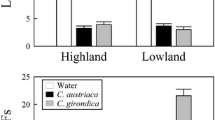Abstract
Four litters of king snakes (Lampropeltis getulus), a snake-eating species, were tested for responses to chemicals from colubrid and crotaline snakes. King snakes presented with swabs rubbed against the dorsal skin of living snakes and with swabs treated with methylene chloride extracts of shed snake skins tongue-flicked more to swabs from a northern copperhead (Agkistrodon contortrix), a crotaline, than to swabs from some colubrid snakes or to blank swabs. Six out of 10 king snakes in one litter attacked and attempted to ingest swabs treated with snake skin chemicals, implicating these chemicals as feeding stimuli for these ophiophagous snakes. Ingestively naive king snakes presented with plain air and snake odors in an olfactometer tongue-flicked more to snake odors. This study and others suggest that crotaline and colubrid snakes can be distinguished by chemical cues.
Similar content being viewed by others
References
Ahern, D.G., andDowning, D.T. 1974. Skin lipids of the Florida indigo snake.Lipids 9:8–14.
Allyn, W.P. 1937. Studies on poisonous snakes of Indiana.Proc. Indiana Acad. Sci. 46:220–224.
Bogert, C.M. 1941. Sensory cues used by rattlesnakes in their recognition of ophidian enemies.Ann. N. Y. Acad. Sci. 41:329–343.
Bonnett, D.E., andGuttman, S.I. 1971. Inhibition of moccasin (Agkistrodon piscivorus) venom proteolytic activity by the serum of the Florida kingsnake (Lampropeltis gelulus floridana).Toxicon 9:417–425.
Brock, O.G., andMeyers, S.N. 1979. Responses of ingestively naiveLampropeltis getulus (Reptilia, Serpentes, Colubridae) to prey extracts.J. Herpetol. 13:209–212.
Burghardt, G.M. 1970. Chemical perception in reptiles, pp. 241–308,in J.W. Johnston, Jr., D.G. Moulton, and A. Turk (eds.). Communication by Chemical Signals. Appleton-Century-Crofts, New York.
Burghardt, G.M. 1977. The ontogeny, evolution, and stimulus control of feeding in humans and reptiles, pp. 253–275,in M. Kare and O. Maller (eds.). The Chemical Senses and Nutrition. Academic Press, New York.
Burghardt, G.M., andAbeshaheen, J.P. 1971. Responses to chemical stimuli of prey in newly hatched snakes of the genusElaphe.Anim. Behav. 19:486–489.
Chiszar, D., Scudder, K., Knight, L., andSmith, H.M. 1978. Exploratory behavior in prairie rattlesnakes (Crotalus viridis) and water mocassins (Agkistrodon piscivorus).Psychol. Rec. 28:363–368.
Clark, R.F. 1949. Snakes of the hill parishes of Louisiana.J. Tenn. Acad. Sci. 24:244–261.
Cowles, R.B. 1938. Unusual defense posture assumed by rattlesnakes.Copeia 1938:13–16.
Cowles, R.B., andPhelan, R.L. 1958. Olfaction in rattlesnakes.Copeia 1958:77–83.
Czaplicki, J.A., Porter, R.H., andWilcoxon, H.C. 1975. Olfactory mimicry involving garter snakes and artificial models and mimics.Behaviour 54:60–71.
Dunbar, G.L. 1979. Effects of early feeding experience on chemical preference of the northern water snake,Natrix s. sipedon (Reptilia, Serpentes, Colubridae).J. Herpetol. 13:165–169.
Eisner, T., andGrant, R.P. 1981. Toxicity, odor aversion, and “olfactory aposematism.”Science 213:476.
Graves, B.M., andDuvall, D. 1983. Occurrence and function of prairie rattlesnake mouth gaping in a nonfeeding context.J. Exp. Zool. 227:471–474.
Halpern, M., andKubie, J.L. 1983. Snake tongue flicking behavior: Clues to vomeronasal system functions, pp. 45–72,in D. Müller-Schwarze and R.M. Silverstein (eds.). Chemical Signals in Vertebrates 3, Plenum Press, New York.
Hamilton, W.J., andPollack, J.A. 1956. The food of some colubrid snakes from Fort Benning, Georgia.Ecology 37:519–526.
Hennessey, D.F., andOwings, D.H. 1979. Snake species discrimination and the role of olfactory cues in the snake-directed behavior of the California ground squirrel,Behaviour 65:115–124.
Klauber, L.M. 1972. Rattlesnakes, Their Habits, Life Histories and Influence on Mankind, Vol. 2. University of California Press, Berkeley.
Marchisin, A. 1980. Predator-prey interactions between snake-eating snakes and pit vipers. Unpublished dissertation, Rutgers University.
McIlhenny, E.A. 1935. The Alligator's Life History, Christopher Publishing House, Boston.
Meade, G.P. 1940. Observations on Louisiana captive snakes.Copeia 1940:165–168.
Neill, W.T. 1947. Size and habits of the cottonmouth moccasin.Herpetologica 3:203–205.
Neill, W.T. 1971. The Last of the Ruling Reptiles: Alligators, Crocodiles, and Their Kin. Columbia University Press, New York.
Roberts, J.B., andLillywhite, H.B. 1983. Lipids and the permeability of epidermis from snakes.J. Exp. Zool. 228:1–9.
Roberts, J.B., andHelmkamp, G.M., Jr. 1982. Composition of epidermal lipids in squamate reptiles.Clin. Res. 30:802A.
Rubinoff, I., andKropach, C. 1970. Differential reactions of Atlantic and Pacific predators to sea snakes.Nature 228:1288–1290.
Sokal, R.R., andRohlf, F.J. 1981. Biometry. W.H. Freeman, San Francisco.
Weldon, P.J. 1982. Responses to ophiophagous snakes by snakes of the genusThamnophis.Copeia 1982:788–794.
Weldon, P.J., andBurghardt, G.M. 1979. The ophiophage defensive response in crotaline snakes: Extension to new taxa,J. Chem. Ecol. 5:141–151.
Williams, P.R., Jr., andBrisbin, I.L., Jr. 1978. Responses of captive-reared eastern king snakes (Lampropeltis getulus) to several prey odor stimuli.Herpetologica 34:79–83.
Author information
Authors and Affiliations
Rights and permissions
About this article
Cite this article
Weldon, P.J., Schell, F.M. Responses by king snakes (Lampropeltis getulus) to chemicals from colubrid and crotaline snakes. J Chem Ecol 10, 1509–1520 (1984). https://doi.org/10.1007/BF00990320
Received:
Revised:
Issue Date:
DOI: https://doi.org/10.1007/BF00990320




